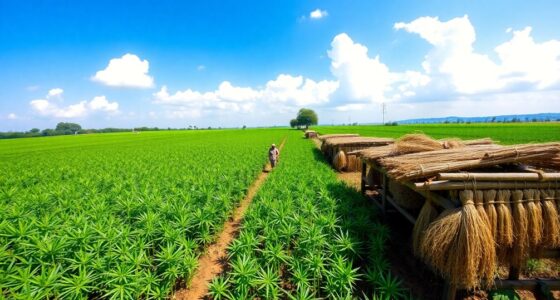Efforts to save species have shown that recovery is possible, even amid falling biodiversity. Take the bald eagle and American alligator, for example; both have bounced back from near extinction due to strict regulations and habitat protections. Their successes highlight the power of collective action in conservation. By uniting communities, organizations, and governments, we can drive meaningful change. If you're curious to explore more recovery stories, there's much more to uncover about successful conservation initiatives.
Key Takeaways
- Successful conservation efforts, like the bald eagle and American alligator recoveries, demonstrate the effectiveness of collective action in species protection.
- Community involvement, government support, and organizational collaboration have led to significant population rebounds for several endangered species.
- Targeted strategies, such as habitat protection and regulated hunting, have proven essential for species recovery across various ecosystems.
- Inspirational recovery stories, like that of the California condor and gray wolf, highlight the potential for reversing biodiversity loss through dedicated efforts.
- Ongoing commitment to conservation initiatives is crucial for maintaining biodiversity and ensuring the survival of threatened species.

As you explore the world of conservation, you'll discover remarkable stories of species recovery that inspire hope. One of the most notable successes is the recovery of the bald eagle, a symbol of American strength and resilience. Once teetering on the brink of extinction, the bald eagle's numbers dwindled to about 480 breeding pairs in the 1960s due to habitat loss, pesticide use, and hunting.
Thanks to dedicated conservation efforts, including the banning of DDT and the establishment of protected habitats, these majestic birds have rebounded spectacularly. Now, over 14,000 pairs soar across North America, showcasing the power of collective action in reversing the effects of human impact. This remarkable comeback represents a significant symbol of strength in conservation success.
This achievement illustrates that successful conservation isn't just a dream; it's a reality when communities, organizations, and governments unite for a common cause. You'll find similar stories across the globe. The recovery of the American alligator, once listed as endangered, is another testament to effective conservation practices. By implementing strict hunting regulations and habitat protection, their population has soared from near extinction to nearly 2 million.
Successful conservation is achievable when communities unite, as seen in the recovery of the American alligator.
As you delve deeper, you'll encounter the stories of the California condor and the gray wolf, both of which faced dire threats. Intensive breeding programs, habitat restoration, and public education have played pivotal roles in their recovery, bringing these iconic species back from the edge.
While biodiversity is declining globally, these examples show that it's possible to turn the tide. Every species saved from the brink not only enriches our ecosystems but also reinforces the idea that conservation can succeed.
Frequently Asked Questions
What Are the Main Causes of Biodiversity Loss Today?
Biodiversity loss today stems mainly from habitat destruction, invasive species, and overexploitation.
You'll notice how urbanization and agricultural expansion fragment natural habitats, impacting species survival. Climate change alters ecosystems, while pollution harms both species and habitats.
Additionally, population growth drives resource demand, further exacerbating these issues.
Without effective regulation and conservation efforts, you're likely to witness increased extinction rates and disrupted ecosystems, diminishing the planet's biodiversity and vital ecological services.
How Do Conservation Efforts Impact Local Economies?
Conservation efforts significantly boost local economies by creating jobs and attracting tourism.
When you invest in preserving natural areas, you not only enhance property values but also open up new opportunities for local businesses.
Nature-based tourism brings in visitors who spend money, which benefits shops and hospitality services.
What Role Do Individuals Play in Saving Species?
Did you know that one in four species faces extinction? You play a crucial role in saving these species by supporting conservation organizations, practicing sustainable behaviors, and advocating for effective policies.
By donating your time or money, you help fund vital projects. Reducing your carbon footprint and choosing sustainable products make a difference too.
Engaging in community actions, like cleanups, creates healthy ecosystems and promotes awareness, ensuring a brighter future for wildlife.
Are There Any Successful Case Studies of Species Recovery?
Yes, there are several successful case studies of species recovery you should know about.
The Whooping Crane's population has increased due to breeding programs at the Calgary Zoo.
Similarly, the Peregrine Falcon has rebounded thanks to legal protections and recovery efforts.
The Arabian Oryx was saved through breeding and reintroduction initiatives, while the Humpback Whale's population grew after international whaling bans.
These examples show that targeted actions can lead to remarkable recoveries.
How Does Climate Change Affect Biodiversity?
Imagine a fragile glass globe, representing our planet's biodiversity. As climate change heats the atmosphere, that globe starts cracking; rising temperatures disrupt habitats, and ocean acidification erodes marine life.
Extreme weather events strike, pushing species to migrate or face extinction. You witness plants wilting, animals dwindling, and ecosystems shifting.
This symbolizes the urgency of protecting our biodiversity, as every crack in that globe threatens the delicate balance of life we all depend on.
Conclusion
In the fight to save our planet's species, every effort counts, like drops of water filling a thirsty well. You've seen how dedicated conservationists are turning the tide against biodiversity loss, proving that hope still exists. It's crucial to support these initiatives, whether through awareness or action, because together, we can create a ripple effect that nurtures our planet's rich tapestry of life. Let's join hands and safeguard the future for generations to come.









